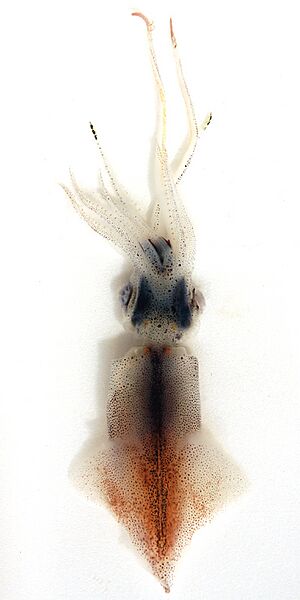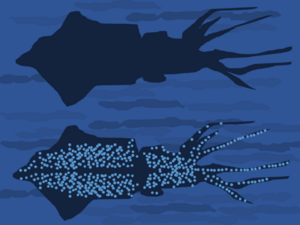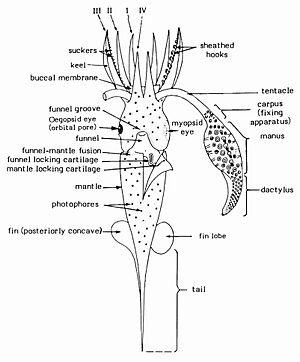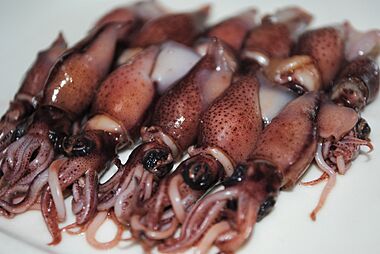Firefly squid facts for kids
Quick facts for kids Firefly squid |
|
|---|---|
 |
|
| Conservation status | |
| Scientific classification | |
| Genus: |
Watasenia
|
| Species: |
scintillans
|
| Synonyms | |
|
|
The firefly squid (Watasenia scintillans) is a small, glowing squid found mainly off the coast of Japan. It's also known as the sparkling enope squid or hotaru-ika. This amazing creature is the only species in its group, Watasenia.
These tiny squid spend most of their lives in deep ocean waters, about 200 to 400 meters (650 to 1,300 feet) down. But each spring, they come closer to the shore to lay their eggs. Firefly squid are famous for their bioluminescence, which means they can make their own blue light. Scientists think they use this light to talk, hide from enemies, or even attract food.
Firefly squid are predators. They actively hunt small creatures like copepods, tiny fish, and even other small squids. Their lives are quite short, usually about one year. After the females lay their eggs near the shore, they die. This yearly journey of millions of glowing squid creates a stunning blue light show in the bay. It's a big event for both fishermen and tourists in Japan.
Contents
Body and Features
The firefly squid is a type of Cephalopod, which is a group of sea animals that includes octopuses and cuttlefish. Like other squid, it has a clear head and a main body part called a mantle. Its body is symmetrical, meaning both sides are mirror images.
These soft-bodied creatures have a skeleton made of a material called chitin. They have large eyes, eight arms, and two long tentacles. What makes them special are the hooks on their tentacles, which helps scientists classify them.
An adult firefly squid is usually about 7.5 centimeters (3 inches) long. They are reddish-brown but can glow with blue and green light. This light comes from special organs called photophores.
Firefly squid have three kinds of photophores:
- Hundreds of tiny ones (800-1000) cover the underside of their body.
- Five larger ones are found around each eye.
- Three very large ones are on the tip of each of their fourth pair of arms.
The small photophores on their body can make both blue and green light. The ones near their eyes and on their arms only make blue light. The photophores on their arm tips produce a very bright light that you can see easily. This special light system helps the squid find food and avoid predators.
Where They Live
The firefly squid lives in the ocean waters off the coast of Japan. The depth where they live changes throughout the day. During the day, they stay deep, around 300-400 meters (980-1,300 feet). At night, they swim up closer to the surface, about 20-60 meters (65-200 feet) deep. This daily up-and-down movement is called diel vertical migration.
Because they move between different depths, they also experience big changes in water temperature. It can be 3-6°C (37-43°F) during the day and 5-15°C (41-59°F) at night. Every year, many firefly squid gather in Toyama Bay for their breeding season.
What They Eat and Who Eats Them
The diet of a firefly squid changes as it grows. When they are very young, called paralarvae, they mostly eat tiny sea creatures called copepods. As they get older, they start to eat a wider variety of food. This includes small crustaceans, fish, and even other squid.
Many animals hunt firefly squid. They are an important food source for some predators, like northern fur seals, especially during their yearly migration. Since the squid spends its day in deep waters and comes up at night, it uses its light to hide.
This hiding trick is called counter-illumination camouflage. The squid matches the brightness and color of its glowing underside to the light coming from the surface. This makes it very hard for predators below to see them. Firefly squid mostly eat at night, which is when they are closer to the surface.
Bioluminescence and Vision

How They See in the Deep
Firefly squid live in the deep parts of the Western Pacific Ocean. Not much sunlight reaches these depths. The light that does get through is mostly blue, green, and yellow. These colors have more energy and can travel deeper into the water.
The squid's eyes are specially made to catch as much light as possible in this dim environment. They have large pupils, like the opening in your eye, to let in more light. Their eyes also have a special lens that helps them see clearly without much distortion.
Scientists have found that firefly squid have three different light-sensing pigments in their eyes. This is very unusual for squid and might mean they can see colors! Most cephalopods don't see colors, so this would be a special ability for the firefly squid. These pigments are located in different parts of their retina, which is the light-sensitive layer at the back of the eye. This unique setup helps them see clearly in the deep, dark ocean.
Life Cycle
Most cephalopods, like squid and octopuses, mate with many partners. However, firefly squid show signs of being monogamous, meaning they might only mate with one partner. Each spring, they travel to the coastal waters of Toyama Bay in Japan to mate.
After the female squid lays her fertilized eggs, she dies. This marks the end of her one-year life. The spawning season, when huge groups of squid gather, happens between February and July.
Commercial Use
Fishermen have known for a long time that firefly squid gather in Toyama Bay to lay their eggs. They are often caught at night when they swim up to the surface. They are also caught during the day in fishing nets that go deep into the ocean.
The glowing blue light of the firefly squid makes them a popular and special item on restaurant menus in Japan. A lot of firefly squid are caught each year. For example, from 1990 to 1999, about 4,804 to 6,822 tons were caught annually.
Keeping firefly squid alive for a long time after they are caught has been tricky. This is because they are used to the cold, dark conditions of the deep sea. But researchers found a way to keep them calm for several days using a special solution. When the squid are put back into fresh seawater, they quickly return to normal and can still flash their lights. This is important for researchers who want to study them.
See also
- List of Special Places of Scenic Beauty, Special Historic Sites and Special Natural Monuments
Sources
Patel, K. and D. Pee 2011. "Watasenia scintillans" (On-line), Animal Diversity Web. Accessed October 9, 2016 at http://animaldiversity.org/accounts/Watasenia_scintillans/




